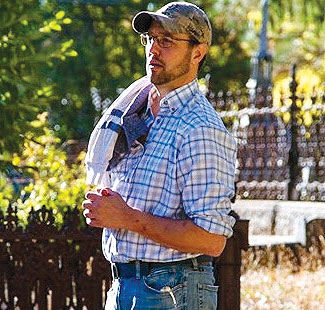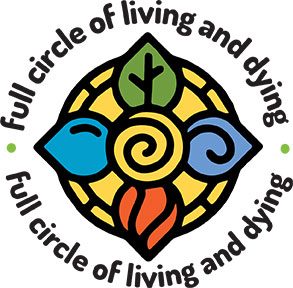
By Trina Kleist
Some people are midwives and doulas, assisting in the process of bringing in life. Akhila Murphy helps people honor a life going out.
“It’s been a part of human existence to take care of your own dead,” says Murphy, a certified end-of-life doula. She founded and runs Full Circle Living and Dying, a Grass Valley nonprofit that supports and guides people interested in home-based care for those who are near death, as well as after-death care, home-based funeral rituals and natural burial. And that requires talking about death itself, a conversation Murphy encourages.
Some people are midwives and doulas, assisting in the process of bringing in life. Akhila Murphy helps people honor a life going out.
“It’s been a part of human existence to take care of your own dead,” says Murphy, a certified end-of-life doula. She founded and runs Full Circle Living and Dying, a Grass Valley nonprofit that supports and guides people interested in home-based care for those who are near death, as well as after-death care, home-based funeral rituals and natural burial. And that requires talking about death itself, a conversation Murphy encourages.
I want people to start talking about death.”
Akhila Murphy
Full Circle Living and Dying
“With this pandemic, so many people were dying, and they never had the opportunities to plan or say goodbye,” Murphy says, referring to the early physical-isolation restrictions amid COVID-19. “Once you start having conversations about death…you start living differently. You start appreciating your life and what’s important.”
In April 2022, Murphy said goodbye to her own mother. Even though Mom could not respond, she was aware. Her grandchildren and great-grandchildren came, held her hand, talked and read to her. She died at home on a Sunday morning.
Doulas from Full Circle came to Murphy’s home to help family members, men and women, wash their matriarch’s body, and left her to lie in state in her bed. “We adorned her with flowers and greenery. The next day, we shrouded her with ceremony before she went into mortuary care,” Murphy recalled. “I felt fortunate that I was able to give my mom that gift, and give to myself and my family, the chance to say a really beautiful goodbye.”
Sitting with the dead
It’s legal to die at home in every state in the nation. It’s also legal to bring home a loved one from a medical facility after death and prepare the body for burial or cremation, Murphy says. It also can be a comfort to those who remain.

“Some traditions call for three days for the body to lie before being taken away” to a mortuary or for burial, Murphy says. During that time, the bereaved can pray, conduct ceremonies, invite visitors and visit with the dead. “Families who do this are so grateful to have that extra time, to get up in the middle of the night, to sit with the deceased, to hold their hand, to say things, to talk, to process things right there,” Murphy says. “Whatever their belief system is can only be enhanced by being there and having more time to process.”
Additional home-based activities take on a ceremonial feel that comforts and consoles. The law does not require that a body be taken to a mortuary or embalmed, a process that uses chemicals to delay decomposition. Instead, Murphy and Full Circle volunteers teach people how to perform time-honored rituals such as washing, dressing and shrouding the body, covering the deceased’s face and carrying the body out. Tradition often defined what men and women could do to honor their dead, but Full Circle encourages everyone to participate in a way that feels meaningful to each one.
Sacred space when an infant dies
Recently, Full Circle Living and Dying began assisting families who’ve suffered the loss of a baby, whether from miscarriage, stillbirth or death after birth. Stillbirth alone claims about 24,000 infants in the United States each year, according to the U.S. Centers for Disease Control.
If the death occurs in the hospital, parents have the legal right to take their infant home and care for its remains there, Murphy says. After birth, it’s possible to place the infant in a CuddleCot™, a small, portable bassinet equipped with a device that cools the baby’s body, allowing the family to take their child home to say goodbye there. A doula associated with Full Circle raised money to buy a CuddleCot™, and the nonprofit makes it available to anyone who needs it.
In addition, another cooling device – the Caring Cradle™ – is available for parents at Sierra Nevada Memorial Hospital. It’s made exclusively for hospital use, but, like the CuddleCot™, it gives families a little more time with a baby who dies. The CuddleCot™ and Caring Cradle™ are tools in a broader movement in the United States encouraging hospitals to provide more sensitive services to families grieving the death of an infant. CuddleCots are widely available in hospitals in the United Kingdom, according to the nonprofit Ashlie’s Embrace.
Learn more about caring for loved ones before, during and after death
- Full Circle Living and Dying
Guidance and education for care
FullCircleLivingDyingCollective.com
530-270-9839
Educational presentations are listed under “Events/News” - Nevada Cemetery District
NevadaCemeteryDistrict.com
530-265-3461 - International End-of-Life Doula Association
INELDA.org - CuddleCot™
CuddleCot.com - Caring Cradle™
CaringCradle.com
Natural green burial allows “dust to dust”

At the Cherokee Cemetery on the San Juan Ridge, people can bury their dead right in the ground, lay flowers, fill the grave and plant their own commemorative markers. A portion of the cemetery was set aside in 2015 for “natural green” burials, thanks to the advocacy of Nevada County Cemetery District board members and Manager Matt Melugin. The green sections allow no steel-and-cement grave liners, no metal caskets, no embalmed bodies, and no lawn above that requires chemical fertilizers and pesticides.

Just caskets that decompose naturally along with the remains of the deceased, giving renewed power to the biblical directive, “…for you are dust, and to dust you shall return.” “Natural, green burial is more environmentally friendly,” Murphy says.
Cherokee is one of 27 public facilities in the Nevada Cemetery District, and any county resident may be buried in those cemeteries that still are active. In addition to Cherokee, cemeteries in Rough and Ready and Red Dog have sections for natural green burial, Melugin said.
“It was a very community-driven thing,” Melugin says of the two-year process to investigate and approve natural green burial. “We were the first public cemetery to do this in California.”
Continuing education for all steps in the going-out
Murphy and Full Circle volunteers offer information about and help with a wide range of options for care before, during and after death. Doulas with Full Circle can provide care to those who are dying, plus support and guidance through the dying process. They can also help a family or dying person collect important documents and plan a funeral and other rituals. People can learn how to shroud a body, create an altar and donate organs.
In California and some other states, medically assisted death is legal in narrowly defined circumstances. Our volunteers can answer questions about the state’s End-of-Life Option Act.
“We just try to empower people,” Murphy says. “I just want people to start talking about death.”
Symbolism of Full Circle Living and Dying’s logo

Many cultures and faith traditions embrace the science of the four earth elements. The earth elements represent the basic properties of nature and the life force energies in our world. All matter is made up of a combination of Earth, Water, Fire and Air including our human bodies. These four elements support the life force energy of our bodies, and when the body moves into the dying process, these energies begin to dissolve in a common pattern. The dissolution of elements has been studied and documented by traditions such as Buddhism, and our logo is patterned after these teachings. While FCLD is not a Buddhist-based organization, we borrow from the Buddhist perspective, which describes the dissolution process at the end of life.
Natural Green Burial

There are only a handful of cemeteries in California that offer green or natural burial. The Green Burial Council outlines guidelines for various levels of green burial. The new option, a Natural Green Burial program adopted by the Nevada Cemetery District for Cherokee Cemetery in North San Juan is of the highest level of compliance. An entire section of Cherokee (plus Rough and Ready and Red Dog cemeteries) will be reserved for green burial only. Shrouds, cardboard and pine caskets without metals or toxic glues are allowed. Natural stone grave markers, family participation, and graveside ceremonies are allowed. Embalming and grave liners are not allowed. There are no lawns to be maintained and watered, no pesticides use, and the burial grounds at Cherokee consist of natural grasses, shrubs and tall oaks and pines. Very affordable fees.
NevadaCemeteryDistrict.com
Freelance writer Kylene Yumul contributed to this report.
